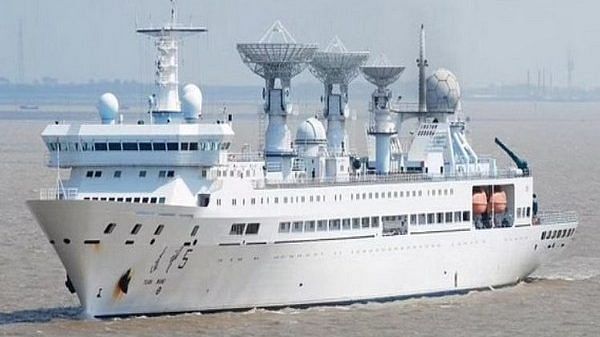By docking its ballistic missile and satellite tracking ship Yuan Wang 5 at Hambantota in Colombo, China has found a convenient port closest to India and a willing partner in Sri Lanka. For New Delhi, it’s a wake-up call. The docking of the ‘spy’ ship in its neighbourhood not only emphasises China’s influence – read control – over Sri Lanka, but also makes a larger point about the potential power shift underway in the Indian Ocean region. New Delhi would be well advised to read the tea-leaves before it is too late.
The Yuan Wang 5, which will likely be stationed at Hambantota Port until 22 August, ostensibly for refuelling and replenishment, is equipped to snoop on defence and strategic assets in its periphery – 750-km radius which includes six Indian ports, and Koodankulam and Kalpakkam nuclear facilities.
Beijing has claimed the ship is used for scientific research in keeping with international covenants and its activities should not be “obstructed by any third party”. New Delhi, while clarifying it was aware of the ship’s movement, said it recognises Colombo’s sovereignty to make its own decisions. External Affairs Minister S. Jaishankar said that any development in India’s neighbourhood that has a bearing on the nation’s security is “obviously of an interest to us”.
But Beijing’s ambition is key here.
China’s objective to establish itself as a pre-eminent superpower in the region and then catapult itself to alter the world order cannot be dismissed as mere wishful thinking anymore.
It is no secret that China’s ultimate hegemonic option is to become a strong military power so that it can station its land, air, sea and outer space-based assets anywhere and become a “great modern socialist country” by 2049. As part of his vision for China, Xi Jinping has set out an agenda sanctioned by the Chinese Communist Party. Those who apprehend the lack of continuity of this agenda in the post-Xi era are either naïve or ignorant of China’s strategic planning and execution capabilities.
Also read: Sri Lanka walks a tightrope — Chinese ‘credit card’ on one side, Indian friendship on other
Rivaling US and succeeding
There can be little disagreement on the fact that China will equal the military strength of the US in another two decades if not surpass the US’ defence technology capabilities. China is already ahead of the US in land-based conventional ballistic and cruise missiles, integrated air defense systems and shipbuilding.
As against conventional Ground Launched Ballistic Missiles (GLBM) with a range of 70 to 300 kms of the US, China has 1250 GLBMs. China has replaced its older version of long-range surface-to-air missiles and replenished its air defence systems with Russian built S-400 and S-300, integrating it with domestic military hardware. China’s navy is the largest in the world as of now with a battle-ready force of nearly 350 ships and submarines including about 130 surface combatants. The US had about 293 ships in 2020.
Production of the Yuan Wang-class of ships (meaning ‘Long View’ in Mandarin) was proposed by Premier Zhou Enlai in 1965, and endorsed by Mao Zedong in 1968. Yuan Wang 5, China’s third-generation ship with outer-space, satellite and ICBMs observation capabilities, has been cruising in the waters close to Fiji for three years. This class of ships has been deployed in three major oceans: YW1 and YW2 in the Pacific, YW3 covering the Atlantic coast, and YW4 in the Indian Ocean.
After operationalising Djibouti, China has Chabahar, Gwadar and Karachi for logistic support. From being a secondary theatre for China, the Indian Ocean Region has become a prime area of operation with the docking of YW5. This should be understood in the context of the 2006 and 2008 white papers focussing on the need for the Chinese navy to develop capabilities to conduct “cooperation in distant waters” in the wake of rising global competition for resources.
Also read: The role China played in pushing Sri Lanka into a debt trap & what India can do to help
India can ‘emulate the enemy’
The Indian Ocean Region’s importance cannot be undervalued in relation to its salience for the wider Indo-Pacific region and its areas of activities. An arms race and serious power contestations in the Indian Ocean will jeopardise the progress of fragile emerging economies in the region and exert extreme pressure on India’s economic plans and developmental assistance programmes.
India will have to do much more than just keep a watch on the emerging situation in the Indian Ocean. We can ill afford to allow ‘distant powers’ to use our maritime backyard as an arena for their power posturing. China’s power to operate in the waters of the Indian Ocean may match that of the US or appear to be even better. It would not be strategically wise on the part of New Delhi to partner with and depend on the US alone to counter China, which has been the intention of Washington anyway. India will have to impress upon the Quad members to work as a group to forge a strong anti-access strategy in the Indian Ocean and the larger Indo-Pacific region.
Meanwhile, New Delhi can ‘emulate the enemy’ and strengthen indigenous defence production, invest more in building naval capabilities, increase economic engagements with immediate and extended neighbourhoods, and conduct assertive if not aggressive diplomacy in the region while tackling the Yuan Wang 5 ship issue.
The author is the former editor of ‘Organiser’. He tweets @seshadrichari. Views are personal.
(Edited by Prashant)



